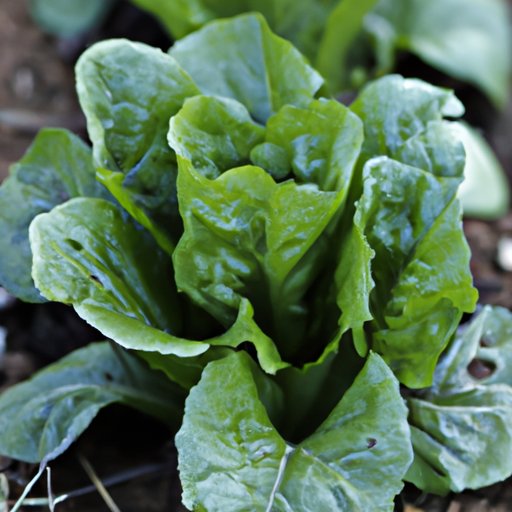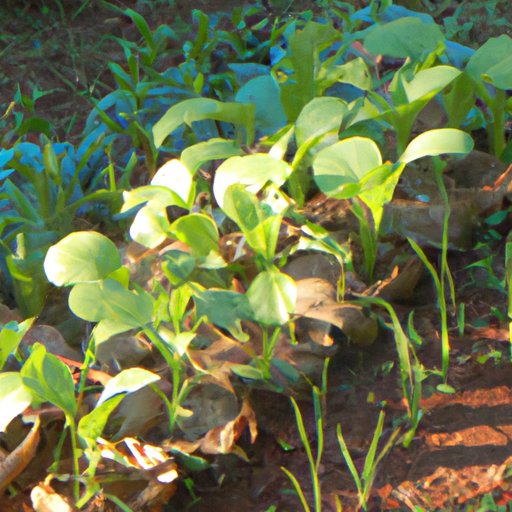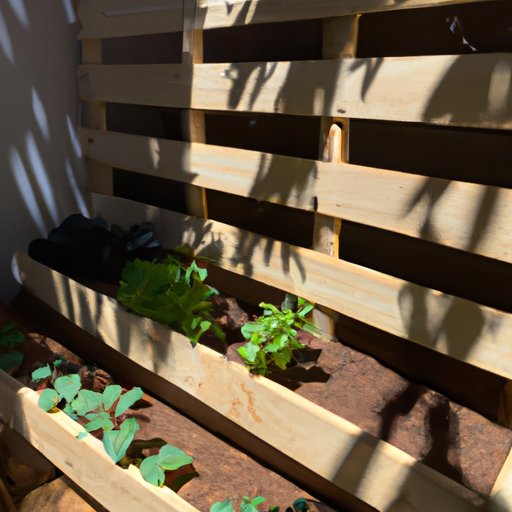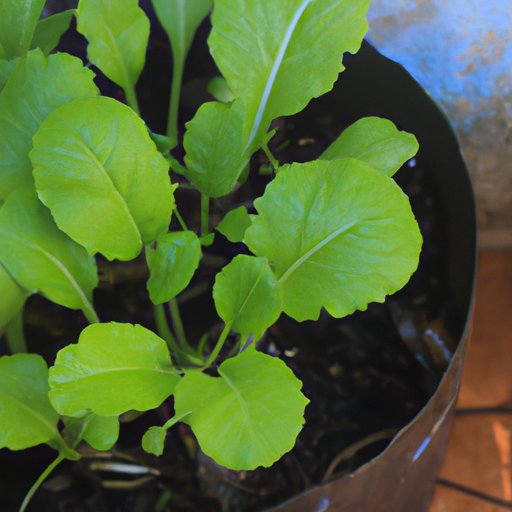Introduction
Growing vegetables in the shade can be a great way to make the most of your garden space. Shade-loving vegetables are generally hardy and easy to maintain, and they can thrive without direct sunlight. But what exactly are shade-loving vegetables? And how do you go about growing them successfully? Read on for a comprehensive guide to growing vegetables in the shade.
A Guide to Shade-Loving Vegetable Varieties
When it comes to growing vegetables in the shade, there are many varieties to choose from. Leafy greens, root vegetables, and fruiting vegetables can all be grown in partial shade. Here are some of the best options for each category.
Leafy Greens
Leafy greens such as lettuce, spinach, arugula, and kale are all excellent choices for growing in the shade. These vegetables require little sunlight and are often planted in early spring when the sun is still low in the sky. They can also be planted in late summer or early fall for a second harvest.
Root Vegetables
Root vegetables such as carrots, radishes, turnips, and beets are all suitable for growing in the shade. These vegetables are relatively easy to grow and can tolerate partial shade. However, they require well-draining soil and plenty of moisture.
Fruiting Vegetables
Fruiting vegetables such as tomatoes, peppers, eggplants, and squash can also be grown in the shade. These vegetables need more sunlight than leafy greens and root vegetables, but they can still thrive in partial shade. For best results, plant them near a south-facing window or in an area with filtered light.

Grow a Bounty of Vegetables in the Shade
Once you have chosen the varieties you want to grow, there are a few steps you’ll need to take to ensure success. Preparing the soil, understanding your plants’ sunlight requirements, and providing adequate water and nutrients are all key components of successful vegetable gardening in the shade.
Preparing Soil and Planting
Before planting your vegetables, it’s important to prepare the soil. If you’re planting in containers, use a potting mix specifically designed for container gardening. If you’re planting in the ground, add organic matter such as compost or aged manure to improve drainage and nutrient availability. Once the soil is prepared, you’re ready to start planting.
Sunlight Requirements
Different vegetables require different amounts of sunlight. Leafy greens and root vegetables can usually get by with only a few hours of direct sunlight a day, while fruiting vegetables may require up to six hours of direct sunlight. It’s important to understand your plants’ specific needs and adjust their placement accordingly.
Water and Nutrient Requirements
Vegetables need plenty of water and nutrients to thrive. Make sure to water your plants regularly and provide them with adequate fertilizer. Organic fertilizers such as compost tea or fish emulsion are great options. It’s also a good idea to mulch around your plants to help retain moisture and reduce weeds.
How to Plant and Care for Shade-Tolerant Vegetables
Once your vegetables are planted, there are a few maintenance tasks you’ll need to perform to keep them healthy. Mulching, pruning, and pest control are all important parts of caring for shade-tolerant vegetables.
Mulching
Mulching is one of the most important steps in caring for shade-tolerant vegetables. Adding a layer of organic material around your plants will help retain moisture and suppress weeds. It’s also an effective way to add nutrients to the soil and protect your plants from extreme temperatures.
Pruning
Pruning is another important part of caring for shade-tolerant vegetables. Pruning helps promote healthy growth and can prevent disease. It also helps reduce competition between plants, allowing them to receive more sunlight and nutrients.
Pest Control
Pests can be a major problem for shade-tolerant vegetables. To minimize pest damage, use insecticidal soap or natural predators such as ladybugs or lacewings. You can also use floating row covers to keep pests away from your plants.

Planting and Growing Vegetables in Shaded Areas
Shaded areas can be a challenge for vegetable gardens, but there are several ways to maximize your garden’s potential. Container gardening, raised beds, trellises, and other creative solutions can help you make the most out of your shaded garden space.
Container Gardening
Container gardening is a great option for shaded areas. Choose lightweight containers that are easy to move around, and make sure they have adequate drainage holes. You can also use self-watering containers to reduce the amount of time spent watering your plants.
Raised Beds
Raised beds are an ideal solution for shaded areas. They allow you to take advantage of the limited sunlight available, and they also make it easier to control soil temperature and moisture levels. Raised beds can also help improve soil drainage and create a more hospitable environment for your plants.
Trellises
Trellises are a great way to maximize your garden’s potential. Trellises can be used to support climbing plants such as tomatoes, peas, cucumbers, and squash. They can also help maximize the amount of sunlight available to your plants, which can be especially helpful in shaded areas.
Maximizing Your Garden Yield by Growing Vegetables in the Shade
In addition to choosing the right varieties and planting methods, there are a few other strategies you can use to maximize your garden’s yield. Companion planting, crop rotation, and intercropping are all great ways to ensure that your vegetables get the nutrients and sunlight they need.
Companion Planting
Companion planting is the practice of planting two or more plants together to benefit each other. This can be especially useful in shaded areas, where two plants that require different amounts of sunlight can be planted together. For example, you could plant a tall tomato plant next to a short lettuce plant to maximize the amount of sunlight available to both plants.
Crop Rotation
Crop rotation is another great way to maximize your garden’s yield. This involves rotating the crops you plant in a particular area over time. This helps ensure that your plants get the nutrients they need and prevents certain diseases from becoming too prevalent.
Intercropping
Intercropping is a technique that involves planting two or more crops in the same area. This can be beneficial in shaded areas, as it allows you to maximize the amount of sunlight available to each plant. Intercropping can also help reduce competition between plants and increase diversity in your garden.

Creative Ideas for Growing Vegetables in Partial Shade
If you’re looking for even more creative solutions for growing vegetables in the shade, there are a few options to consider. Vertical gardening, greenhouse gardening, and hydroponic gardening are all great ways to maximize your garden’s potential.
Vertical Gardening
Vertical gardening is a great way to make the most of your limited space. Vertical gardens can be created using trellises, hanging planters, or even wall-mounted planters. This type of gardening is perfect for smaller areas, and it can also help maximize the amount of sunlight available to your plants.
Greenhouse Gardening
Greenhouse gardening is another great option for shaded areas. Greenhouses provide the perfect environment for growing vegetables, as they can be adjusted to provide the optimal amount of sunlight, humidity, and temperature. They’re also an excellent way to extend the growing season and protect your plants from extreme weather conditions.
Hydroponic Gardening
Hydroponic gardening is a method of growing plants without soil. Instead, plants are grown in a nutrient-rich solution. This type of gardening is perfect for shaded areas, as it requires minimal sunlight and can be done indoors. Hydroponic gardening is also a great way to conserve water and reduce the risk of pests and diseases.
Conclusion
Growing vegetables in the shade can be a rewarding experience. There are many different varieties to choose from, and with the right preparation and care, you can enjoy a bountiful harvest. By utilizing creative solutions such as container gardens, raised beds, and trellises, you can make the most of your shaded garden space and maximize your garden’s potential. With a bit of patience and dedication, you can have a thriving vegetable garden in no time.
(Note: Is this article not meeting your expectations? Do you have knowledge or insights to share? Unlock new opportunities and expand your reach by joining our authors team. Click Registration to join us and share your expertise with our readers.)
